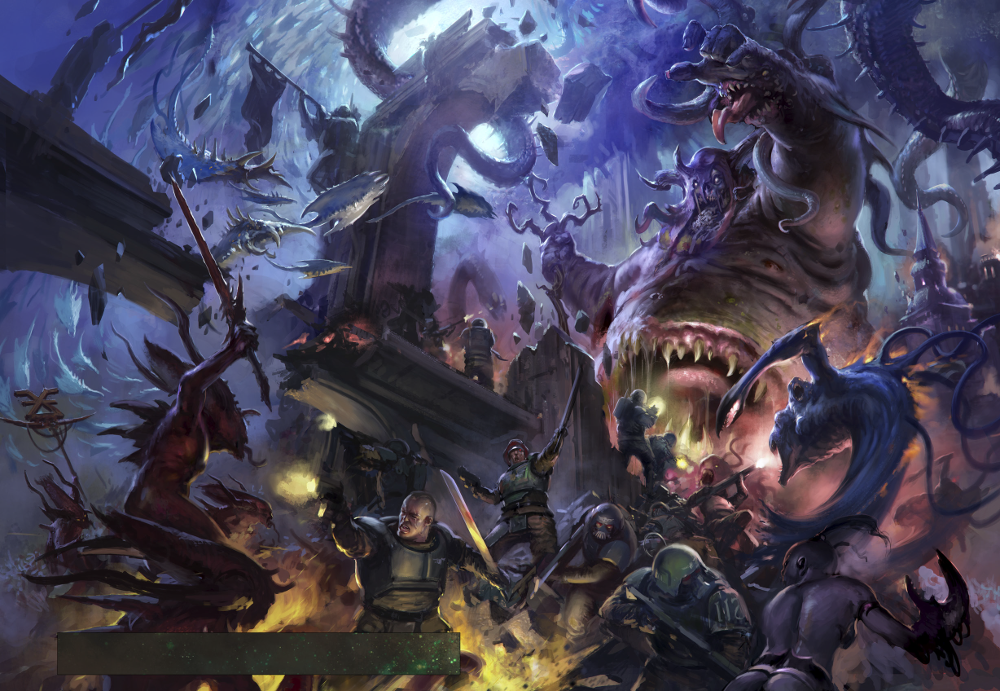
[ Models | Lore | Sources | Inspiration ]
This is the fourth Codex: Chaos Daemons published. It follows Codex: Chaos Daemons (2016).

When at last Chaos came to Cadia, it arrived with fire and plague, bloodied axe and sorcerous blast. Many of its defenders fought to the end, but in desperation, some betrayed their comrades, willingly selling their souls in the hopes of preserving their flesh. Even the mightiest fortifications eventually toppled in the face of the daemonic onslaught, becoming tombstones for an entire world.
There exists a hierarchy of sorts within the ranks of the Ruinous Powers, though it ebbs and flows according to the vagaries of the Great Game. Currently, Khorne is held as the mightiest of all, for the practice of murder and blood sacrifice stretches to the dark beginnings of the universe.
Though Khorne sees the use of sorcery as the refuge of cowards, his closest rival, Tzeentch, thrives on the raw stuff of Chaos and uses it to influence a million times a million plots, his devious mind always a step ahead of his opponents. Where Tzeentch would see hopes thrive and fortunes change, Nurgle, the Father of Plagues, revels in despair and hopelessness. In times of galactic pandemic, Nurgle's power can eclipse even that of his brothers in darkness. Last in the pantheon is Slaanesh, who knows well how to play on the obsessions of his rivals. Khorne's single-minded bloodlust, Nurgle's quest to infect every living thing, and Tzeentch's compulsion to dabble in the fates of mortals - all are obsessions which the Lord of Excess can turn to his will with a whispered promise.
While the Chaos Gods are all enemies in the Great Game, each bears a special enmity for one of their brothers in particular. Khorne most despises Slaanesh, whose earthly decadence and sensual lusts are at odds with the Blood God's martial pride and desire for indiscriminate slaughter; the Dark Prince finds Khorne's artless brutality dull, and takes a perverse delight in agitating him. Similarly, Tzeentch's desire to foster the corrupt ambitions of mortals is at odds with Nurgle's spreading of despair, and so a special rivalry exists between the two.
When Nurgle's minions are set free, they march forth to spread disease and decay. Sonorous chanting and the dolorous clangs of rusted bells herald their attacks, while the army advances under an impenetrable swarm of flies. Capering Daemon-mites carpet the ground before the host, and the noxious poxes of the fleshy hulks that command them kill everything in their path, rendering all life down to mulch from which corrupted fungi and poisonous plants erupt.
Nurgle is the Great Corrupter, the Master of Plague and Pestilence, the fountain and architect of rot itself. He is the embodiment of the truth that all things, no matter how solid and permanent they seem, are subject to decay, and even the process of creation is merely the beginning stage of destruction. The bastion of today is tomorrow's ruin, the maiden of the morning is the crone of the night, and the hope of a moment is but the foundation of regret.
Though he is the creator of every infection and epidemic to have ever afflicted the universe, Nurgle is not a morose purveyor of death and suffering, but a vibrant god of life and laughter. To understand the contradictory nature of the Lord of Decay, one must first comprehend the eternal truths that he represents and the mortal emotions that birthed him.
Life springs from rot. Untold numbers of bacteria, viruses, insects and other carrion-feeders thrive on the decay of the living. From the wake of every plague rise new generations, pox-scarred perhaps, but also stronger than those that came before. Regeneration comes from decay, just as hope is born of despair, the greatest inspiration coming in the darkest moments; in times of crisis, mortals are truly tested and driven to excel.
The citizens of the Imperium know full well that their lives will one day end, and that many of their number will live with disease or other torments in the meantime, yet they drive this knowledge deep into the corners of their minds and bury it with ceaseless activity. Nurgle is partially embodied by that knowledge and the unconscious response to it. He is the hidden fear of disease and decay, the gnawing fact of mortality, and the power of defiance that it generates.
Nurgle himself takes the form of a titanic flesh-hulk riddled with decay and pestilence. His gigantic carcass is bloated with corruption and exudes an overpowering stench that gnaws at the mind. His skin is greenish, leathery and necrotic, its surface abundant with running sores, swelling boils and rampant infestation. Nurgle's gurgling and pulsating organs are rank with the excrement of decay, spilling and spurting through his ruptured skin to hang like obscene fruit around his girth. From these organs burst swarms of tiny Nurglings that chew on his rotting intestines and slurp up Nurgle's bountiful, noxious juices.
Every single human being in the galaxy has been touched by Nurgle's foetid hand at some point. Countless trillions are host to his malignant, invisible creations, which corrupt their physical forms and sow despair in their minds. Interplanetary traffic ensures that contagious diseases are carried from world to world by the ignorant and the wilful alike. As Nurgle's gifts multiply into full-blown pandemics, his power reaches a peak. Whole systems - even whole sectors - are quarantined as plague runs rife across the stars. Proud civilisations wither away even as the God of Decay conjures obscene new life from their remains. Wherever there are plague pits and mass graves, the rotting splendour of Nurgle shines through.
Despite his consistent generosity, only an enlightened few truly embrace Nurgle's greatness. Yet his worshippers exist in numbers enough to ensure his Daemon servants access the material dimension wherever plague abounds. Of all the Chaos Gods, it is Nurgle who most appreciates the personal touch, and he watches over his followers like a doting patriarch, leading many to refer to him as Grandfather Nurgle.
The domain of Nurgle is not a barren wasteland, but a macabre paradise, a near-infinite jungle of death and pestilence. Tended by the Lord of Decay, this unwholesome realm is home to every pox and affliction imaginable. Twisted, rotten boughs entangled with grasping vines cover the mouldering ground, entwining like broken fingers. Fungi, both plain and spectacular, break through the squelching mulch of the forest floor, puffing out clouds of choking spores. The stems of half-daemonic plants wave of their own accord, unstirred by the stagnant, insect-choked air. Their colours puncture the gloom, havens of cheeriness in a dismal woodland. Human-featured beetles flit along the banks of sluggish, muddy rivers. Reeds rattle, whispering the names of the poxes inflicted upon the worlds of mortals by Great Nurgle or lamenting those that have died from the caress of their creator.
Jutting from amidst this primordial mire is Nurgle's manse. Decrepit and ancient, yet eternally strong at its foundations, the mansion is an eclectic structure of sagging, rotted timbers and broken walls, overgrown with crawling poison ivy and thick mosses. Cracked windows and crumbling stone compete with verdigris-coated bronze, rusted ironwork and lichen-covered cornices to outdo each other with their corrupted charm.
Within these crumbling walls, Nurgle toils. Beneath mildewed and bowed beams, the Great Corrupter carries out his eternal work at a rusted cauldron, a receptacle vast enough to contain all the oceans of all the worlds. Chuckling and murmuring to himself, Nurgle labours to create contagion and pestilence - the most sublime and unfettered forms of life.With every stir of Nurgle's maggot-ridden ladle, a dozen fresh diseases flourish and are scattered across the stars. From time to time, Nurgle reaches down with a clawed hand to scoop a portion of the ghastly mixture into his cavernous mouth, tasting the fruits of his labour. With each passing day, he comes closer to brewing his perfect disease, a spiritual plague that will spread across the extent of the universe and see all living things gathered unto his rotting embrace.
Dwarfed by their grotesque and enormous lord, a host of Plaguebearers are gathered about Nurgle. Each Daemon chants sonorously, keeping count of the diseases created, the mischievous Nurglings that have hatched, and the souls claimed by the Lord of Decay's putrid blessings. This hum drowns out the creaking of the rotten floor and the scrape of ladle on cauldron, so unceasing in its monotony that to hear it is to invite madness.
When Nurgle's diseases wax strong in the mortal realm, his garden blooms with death's heads and fresh filth, and its boundaries encroach upon the lands of the other Chaos Gods. War follows, as Nurgle's adversaries fight back and his Daemon legions take up arms to defend the morbid forest. From such war springs more of the richness of life and death, of triumph over adversity. Though Nurgle's realm and his lead in the Great Game will eventually recede again, his Garden will have fed deeply on the fallen, and will lie in gestate peace until it is ready to swell throughout time and space once more.
Very few mortal eyes have beheld the Garden of Nurgle. Its swamplands constantly wheeze a fog of supernatural diseases, and living beings cannot endure so much as a single breath of its repugnant air. Only Nurgle himself can spare visitors from his garden's toxic affections; when he is expecting company, he will open a path through the gurgling fungus-fronds with a single magnanimous gesture.
Trespassers are viewed poorly in Nurgle's domain, as the seers of Lugganath found to their cost. The Aeldari of that far-flung craftworld have long told the story of the Caged Maiden, wherein Isha, the goddess of fertility and healing, is imprisoned in Nurgle's mansion; there she is forced to imbibe Nurgle's most pleasing concoctions as her grotesque admirer observes their results with building excitement, and Isha's restorative powers ensure the process can be eternally repeated.
The Aeldari believe their myths to be founded in truth, and so it was that when Lugganath was ravaged by the Brittle Coma, a council of its most gifted psykers cast their minds into the domain of Nurgle, in pursuit of Isha, hoping to find their lost goddess and put a halt to their craftworld's deadly malaise. They knew that they would almost certainly die in the attempt, but believed that their souls would ultimately be drawn back into the glittering spirit stones of their comatose bodies. Once safe in their crystal afterlife, they could impart Isha's cure to the Spiritseers and lift Nurgle's curse.
At first, their astrally projected forms appeared to be able to pass through the grasping foliage of Nurgle's garden with ease. Their ghosthelms kept them as insubstantial as spirits and their rune-shielded minds cut through the dismal vegetation, for they were sharper than any corporeal blade. The rot-flies of that realm buzzed loud in alarm, however, and whispered of the intruders into Nurgle's ear.
Just as the seers of Lugganath sighted Grandfather Nurgle's manse in the distance, a great host of Plaguebearers rose up from the mud and began to chant in a droning monotone as they came forward. The seers channelled their psychic energy into great blasts of cleansing blue fire, boiling away huge chunks of Nurgle's army and darting out of the clumsy reach of their foes, but ever more Plaguebearers emerged from the slurry to block their path.
The battle raged for days, and swathes of Nurgle's garden were blasted to ruin in the process. However, in the material dimension, the physical forms of the trespassing seers began to convulse and shake, succumbing to the very plague they hoped to overcome. Slowly, as their bodies shrivelled and their spirit stones turned to rotting mulch, the souls of the seers that were trapped in Nurgle's realm began to pass fully into the immaterium. The soupy atmosphere of the garden seeped into their lungs, worm-riddled mud spattered up their legs, and white-bodied daemonflies clambered into their mouths. Claimed at last, the seers' feet took root as their faces hardened into bark. Their arms split and twisted into gnarled branches, each finger hung with ripening Nurgling-fruit.
The seers of Lugganath remain there still, a copse of wailing trees that brighten Nurgle's leisurely walks and strike a note of despair into the heart of Isha, his immortal captive. Such is the fate of all those who enter uninvited into the heartlands of Nurgle, for even the generosity of Grandfather Plague has its limits.
To those subjected to their loathsome assaults, the legions of Nurgle seem like an amorphous mass, but amidst the shambling anarchy there is purpose and design. Like the stages of the diseases they carry, each Plague Legion is part of an overarching cycle of fecundity and decay, and exists only to see Nurgle's garden flourish and his gifts bestowed.
From the Garden of Nurgle lumber the Plague Legions, the dreaded armies of the Great Corrupter. When they go to war, be it in the Realm of Chaos or realspace, they bring the boundless generosity of their master and the products of his endless labours with them, and leave contagion, anguish and death in their wake.
All Plague Legions are Nurgle's creations, and so carry pestilence and propagate their master's foul will, yet each is associated with specific stages of the Fly Lord's cycle of decay and regeneration. The Fecundus Legions are tasked with the making of diseases; it is they that travel across reality and unreality to gather the raw ingredients that will be added to the cauldron of their foul god, and the worst ills suffered by the mortal races can be attributed to their diligence. The Infecticus Legions are the harbingers of infection, the carriers of new diseases that lay the groundwork for the greater virulence to follow. The Pathogenus Legions are disease fully bloomed, sickness made manifest, the very height of contagion; they are equally capable in both attack or defence, and will be often be deployed to guard key sites within Nurgle's garden or spearhead an assault. The Epidemic Legions contain the most Daemons, for they expand, proliferate, and regenerate; it is they that spread outwards, ensuring initial gains turn into rampaging outbreaks. The Rot Legions revel in decay, their festering powers and potent blessings able to break down anything; more than any other legion, their presence cultivates the ground for the Garden of Nurgle to spread. The Morbidus Legions are the reapers, the tolltakers, and the bringers of death. The Necroticus Legions are the most resilient; they use hopelessness and despair as a weapon, and can absorb terrific punishments. And on it goes, each of the legions specialising in some grotesque aspect of Nurgle's cycle of birth, decay, death and rebirth.
Each Plague Legion is led by a Great Unclean One, a Greater Daemon of Nurgle that acts as its general. They dote over their charges in the manner of a loving parent, cajoling each of their Plague Legion's seven Tallybands upon its appointed tasks. Ever eccentric, Nurgle encourages the same aberrations amongst the most powerful of his shepherds. These unusual traits go as far towards colouring the composition and tactics of the army they lead as does the legion type itself. Some Great Unclean Ones, for example, favour entirely airborne assaults, going to battle with clouds of Plague Drones that darken the skies and excel at aerial strikes. Others enjoy seeing their victims buried in slavering Beasts of Nurgle, or ground slowly into the dirt by wave after wave of mumbling Plaguebearers.
Great Unclean Ones cycle through phases over the course of their immortal lifespans, assuming new mantles with each new legion they take command of; for example, they may lead an Epidemic Legion to spread diseases before moving on to command a Rot Legion in order to bask in such maladies. When the cycle nears its end, a Great Unclean one will scab over with necrotic patches, and in his state of advanced decay will lord over a Necroticus Legion. It is not long before his body will shed the rotting husk of its old skin to reveal the new blooms of fresh disease, and it is then he will once again lead a Fecundus Legion.
Beneath the Great Unclean One are the leaders of the Tallybands, either Daemon Princes or daemonic Heralds such as Poxbringers, Sloppity Bilepipers and Spoilpox Scriveners. Each receives a grandiloquent title of the general's invention, selected to match the bearer's skills, proclivities, or war tasks. Examples include the Lords of Fulsome Filth, the Almighty Bringer of Rancid Decay, or the Sloptoxic Master of Bubbling Buboes.
The Tallybands can vary in size, swelling to epidemic proportions as Nurgle's power waxes or contracting into small, elite warbands when it wanes. At its peak, however, a Tallyband is composed of seven packs of the Lesser Daemons known as Plaguebearers or Plague Drones. Depending upon the predilections of its leader, and the ebb and flow of the cycle, a Tallyband may also include Beasts of Nurgle or swarms of Nurglings, although such anarchic beasts rarely remain with the formation beyond the duration of a battle.
The Septicus Legion was part of the daemonic force that penetrated deep into Ultramar, and participated in the fighting that culminated on Iax. It is led by Septicus himself - the self-styled Pox-Tyrant of the Scourge Stars. On the battlefield, Septicus is accompanied by the Rustclankers - a bodyguard of three Soul Grinders. Shown here are the seven full-strength Tallybands that made up the Septicus Legion as it took part in the Battle of Ioneth Fields and the contamination of the Vinecoast.
The Septicus Legion is one of the Legions Pathogenus - ideal both to manifest and spread disease - and it was their task to conquer and hold Iax. Were it not for the untimely return of Roboute Guilliman, it is a mission they would have successfully completed.
Led by Drog'lar Slimeskin (Spoilpox Scrivener)
Seven Plaguebearer packs and three Beasts of Nurgle
It was the Investus Tallyband that served Septicus as a vanguard on Iax. Its ranks of Plaguebearers formed around Drog'lar as he counted the initial symptoms of disease exhibited by the planet's defenders.
Led by Bzzark the Fly-borne (Daemon Prince)
Seven Plague Drone packs
The winged Daemon Prince Bzzark and his Plague Drones are adept at exploiting weaknesses in the enemy lines, and are often unleashed after the Investus and Dirge Tollers Tallybands have pinned down the foe.
Led by Grizguttage (Spoilpox Scrivener)
Seven Plaguebearer packs, a Beast of Nurgle and a Soul Grinder
With Dribwretch, a hulking Soul Grinder, supplying firepower, the infantry of the Shambling Horde advances into the thick of enemy fire.
Led by Mag-grub Larvalmaster (Poxbringer)
Four Plaguebearer packs, three Plague Drone packs and three Beasts of Nurgle
The Worm-Ridden carry within their bodies the latest of Nurgle's creations, the worm-borne blistereye disease, and it is their task to ensure it spreads.
Led by Giglex (Poxbringer)
Three Plaguebearer packs, four Plague Drone packs, two Beasts of Nurgle and a Nurgling pack
The most fly-covered of all the Septicus Tallybands, it was they that met and defeated the Ultramarines 3rd Company within the corrupted forest of Adellus.
Led by Bhadrub Buboepox (Poxbringer)
Five Plaguebearer packs, two Plague Drone packs and two Nurgling packs
The Plagueswords of Bhadrub held back the Ultramarines that came to halt the legion's defilement of Iax's wellsprings until reinforcements arrived.
Led by Gurglax (Sloppity Bilepiper)
Seven Plaguebearer packs and four Nurgling packs
The Dirge Tollers devastated the Ultramar Defence Forces, Gurglax's mirth attracting a horde of capering Nurglings to his aid.
'A little pruning, some judicious planting and yes, this could be a fine addition to Grandfather's garden. But it needs work, my pretties... oh, so much work. Toll the bells, bring forth our best plagues and poxes - we have much grafting and seed-sowing to do.'
— Pox-Tyrant Septicus, upon viewing Iax, the so-called Garden World of Ultramar
Once more the Imperium is beset by civil war in the Age of Apostasy. It is a time of false prophets and intrigue, of anarchy and war, and in the end, plague. As the stages of the Age of Apostasy unfold, Tzeentch, then Nurgle, become the dominant powers within the Realm of Chaos.
[...]
The droughts of Gaero Alphus worsen and eventually, all animal life is sacrificed to feed the tribes' gnawing hunger. The heat drives the tribesmen to pray for divine aid. They turn to the rain dances of old, even sacrificing their own people in the hope of ending the drought. Grandfather Nurgle and his minions hear, take pity, and grant their wish. Glorious rain comes, but as each day passes, the clouds thicken and grow more menacing. Deserts turn to lakes, arid croplands to rotting soup. Disease grows rampant. On the eighth day, the Tallyman of Nurgle, Epidemius, pushes his way out of the sludge to catalogue the disaster. As constant rain lashes down, the Pathogenus Legions arrive to overcome all. A week later, Gaero Alphus disappears altogether from all Imperial records. Eight entire systems follow, with Rotigus Rainfather leading the Epidemic Legions to spread Nurgle's generosity to surrounding worlds.
[...]
The incessant warring of this period sees the rise of Khorne in the immaterium, and the Blood God is once more first amongst the Great Game's players. The chief victim of Khorne's rise is Nurgle, who falls below all his brothers in power.
[...]
The heretically progressive world of Thruscas Sine eradicates all natural illness from its populace. Nurgle is offended, and infests the world from pole to pole. The Plague Legions run amok, and there are no survivors save a new pestilence that will continue to grow in virulence.
[...]
The craftworld of Lugganath falls prey to the Brittle Coma. Its Seer Council project their spirits into the Garden of Nurgle, hoping to find the cure, but instead they meet a tragic and unsettling end.
[...]
Nurgle sends forth from his garden dozens of Plague Legions to overrun the three sprawling star systems to the galactic north of Ultramar. Once conquered, these worlds become a stronghold for the Plague God's mortal and immortal followers.
[...]
Issuing forth from the Scourge Stars, Nurgle's Plague Legions begin a lengthy campaign to corrupt Ultramar. Although they achieve many triumphs, final victory is thwarted by Roboute Guilliman's masterful counter-attacks. The ensuing stalemate is only broken when Nurgle recalls much of his strength, ordering his most powerful Greater Daemons and their legions to help defend the Scourge Stars.
[...]
Tzeentch tricks Khorne into averting his gaze from his Blood Crusade to look instead upon the Scourge Stars. There, the Blood God espies Nurgle's diseased bloomfields blossoming within realspace. Bellowing with rage, Khorne redirects his legions to attack his brother's growing domain. Dozens of Tzeentch's legions follow in their red wake. So begins the War in the Rift - the largest conflict of the Great Game to ever spill over into reality. In response to the invasions, Nurgle launches seven counter-attacks, the largest of which strikes into the Stygius Sector, for the Plague God rightly suspects Tzeentch is behind the assaults upon his realspace stronghold. Even as Kairos Fateweaver leads an assault upon Nurgle's garden, Rotigus heads the invasion of the Stygius Sector. Slaanesh allies with all three of his brothers at different times, his fickle nature drawing the ire of all, but Khorne especially.
The titanic engagements between the Chaos Gods' legions take place across a hundred fronts, but one single battle stands above all others, for none can match the sheer scale of slaughter that occurs upon the planet of Vigrid. Armies clash and powers of such magnitude are released that the planet, now reshaped into a Daemon world, is shattered, the debris shifting into the warp where the surviving combatants continue their battle as they float upon the formless seas of the immaterium. It is a maelstrom of conflict unending, with each side sending in a constant stream of new legions. Seeking an end to the battle, Tzeentch suggests a contest of champions to settle the matter. Each of the Chaos Gods, sure of their own victory, agrees.
Daemons are chaos incarnate, unfathomable beings of a shifting nature, but there is one constant about each of them, from the lowliest imp to the most towering Greater Daemon: they each conceal a true name. Most such names are a rolling tide of nigh unpronounceable syllables beyond the wit and sanity of most to speak aloud, but to do so is the greatest defence against the unnatural creatures of the warp; to know a Daemon's true name is to hold ultimate power over it, and so their bearers keep them secret, even from each other.
To this end, use-names and titles are utilised instead. These follow certain patterns, although they are recurring themes as opposed to rules. Khorne Daemon use-names are guttural and violent sounding, and those of the Bloodthirsters are often composed of eight syllables or letters, like Khazdrak. Their titles are bold and typically descriptive: the High-handed Slayer, Skullrender, the Unstoppable Fury, and so on. Tzeentch Daemons are most likely to change names and titles, for it often suits their needs to do so; a single Lord of Change might go by many different names and titles at any given time. Nurgle's creations favour names with seven letters, and their epithets are either grandiose or descriptive, such as Feculux the Master Mucanoid. Slaaneshi Daemon use-names utilise sibilant sounds,such as Sslythri or Dryzla, while they have a preference for long, grandiloquent titles such as the Exquisite Matriarch of Agonising Delights.
To the mortal eye, a Greater Daemon of Nurgle is undoubtedly the foulest of all the daemonic servants of the Ruinous Powers. Each of these Great Unclean Ones is shaped in the fashion of Nurgle himself; flyblown, maggot-ridden innards spill into view through the tears and gashes in his swollen belly as he lumbers forwards. Clusters of pustules and weeping buboes erupt from his hide, birthing small swarms of giggling Nurglings. Noxious juices seep from dozens of infected sores, leaving a glistening trail of mucus in the Great Unclean One's wake. Few mortals have the stomach, let alone the will, to oppose such a being.
Great Unclean Ones are Nurgle's lieutenants, the field generals of his Plague Legions. As monstrous and horrific as their appearance is, these Greater Daemons are possessed of a paternal affection at odds with this nightmarish form. Gregarious and sentimental, a Great Unclean One takes pride in the achievements of his followers and looks upon all the creatures in his legion as his 'children', and his underlings look upon him as an embodiment of Grandfather Nurgle. Each Greater Daemon pays careful attention to all of his followers, and is noticeably proud of their appearance and endearing behaviour. A Great Unclean One takes delight in his minions' smallest boils, revelling in the variety and effulgence of their poxes and heaping praise upon them with vociferous proclamations. With a wave of his arms such a monstrosity sends forth his Tallybands, booming words of encouragement and gurgling guffaws across the battlefield. This boundless energy and drive is possessed by all Great Unclean Ones; constantly working to extend the process of rot and decay, they are heedless of their own comfort while parts of the galaxy still remain untouched by Nurgle's bounty.
'Sing, sweet choir of ailments, let voices and buboes rise. Riddle them with juicy poxes, and ooze out their rotting eyes.'
— Ghrubex, Poxlord, Greater Daemon of Nurgle
Where the Greater Daemons of Nurgle's rival gods are disproportionate in their master's favour, the Lord of Decay loves all his children equally - even if some are clearly more accomplished than others. Rather than operating as part of a hierarchical structure, Great Unclean Ones are given epithets and tasks in accordance with the stage of growth and fecundity that they currently represent. Those given the title of Lord Fecundus are chiefly concerned with propagating diseases, and lead Fecundus Legions or serve in the Garden of Nurgle. A Grand Impoxenator title signifies that the Great Unclean One commands an Infecticus Legion, tasked with the spreading of glorious malignancies. It is said that before a Great Unclean One can gain Exalted status, he must first successfully lead a Plague Legion of each stage of the cycle.
Great Unclean Ones are motivated by all the trivial mortal enthusiasms that drive the living. They are ebullient and raucous, full of a natural impulse to organise and achieve. Driven to coordinate Nurgle's chaotic endeavours, a Great Unclean One seeks to instil purpose and function in the daemonic rabble under his command. Globules of yellowy-green spittle fly from his wide mouth as the Great Unclean One urges his minions onwards. With chiding grumbles, the Greater Daemon harries those who are tardy in advancing or who seem less energetic in the pursuit of the goals of Grandfather Nurgle. The love of their minions fills a Great Unclean One with joy, but they are consumed with indignation when a foe seeks to thwart Nurgle, and this escalates to paternal rage when his underlings are harmed.
When roused to war, a Great Unclean One is terrifying to behold. Though ponderous, they are all but unstoppable on the advance, shrugging off the bolts and blades of the foe as though they were naught but bothersome insects. Aided by the momentum of his charge, a Great Unclean One will throw his immense bulk upon his victims with all the force it can muster, the selfless act of generosity warming its rotten heart. Those that survive are met with a combination of diseased plague flails, iron-bladed bileswords, filth-encrusted bileblades and rusted doomsday bells. It is not physical attack alone, however, that makes a Great Unclean One so dangerous; by breathing deeply of the festering powers of the warp, he can summon a pestilent wind to wither his foes, vomit forth a steaming tide of filth, maggots and mucus, or bless his underlings with new tumorous growths that cover over the worst of wounds.
The Great Unclean One known as Rotigus is the epitome of Nurgle's generosity and fecundity. None, save for the Lord of Decay himself, is more attuned to the woes of the world. In their despair, the most defiant of mortals vow to endeavour onwards, despite the utter hopelessness of their situation. Thus do the barren pray for fertility, the growers of crops plead for rain, the starving beg for sustenance. Rotigus listens to each supplication, and to those desperate enough to pledge anything in exchange for life, he promises salvation. And the Rainfather always delivers.
Humming merrily - for he enjoys his work - Rotigus lavishes his attentions upon those that beseech him. With their beasts gone sterile, the agri world of Ullden stood upon the brink of ruin. When the animals began to breed once more, the citizens believed their prayers to an ancient fertility god had been answered. Only when the wretched beasts kept giving birth, covering the ground in mewling, mutated newborns that shrieked to the skies did they realise their doom. When their hydro-tech broke, the T'au Earth caste farmers of Dh'artan were so desperate for rain that they ignored protocol and gave in to the superstitions of the primitive tribes from whom they had usurped the planet. When the downpour first came it was welcome, but soon enough the entire planet became a foetid swamp rife with plague.
Rotigus manifests Nurgle's Deluge - a diseased storm that eternally hovers over him, drenching the Great Unclean One to his innermost folds as they wobble with thunderous laughter. Those foes that do not drown in the presence of Rotigus' generosity find themselves crushed by his massive bulk. As befits his giving personality, Rotigus has also been blessed with a fountain of plenty - the ability to vomit an endless stream of filth. A foul soup of brackish plague water, half-digested rotten flesh and the most acidic biles of the galaxy, the liquid can melt ceramite armour and cause ferrocrete to rot and crumble. Alarmingly, the projectile vomit issues not only from his gaping mouth, but also from his belly maw. Random toothed orifices open up all over Rotigus' voluminous body, snapping and retching septic fluids that seethe with contagion.
With such defences, Rotigus feels no need to carry weapons. Instead he bears a gnarlrod, a branch from the hornbeam tree. Of all the strange and unusual plants within his master's garden, the hornbeam is Nurgle's favourite. In a constant cycle, the tree begins as a seed, sprouts, grows to maturity, sickens with disease, declines and dies in rapid fashion. Every time, its withered corpse sloughs away to reveal a seed from which the cycle begins again. With every rebirth comes a different disease that causes the hornbeam to die in some new and horrific way. The curled branch of Nurgle's beloved tree is a powerful symbol of favour, and the ensorcelled wood is rich in regenerative magic.
Since his participation in the Skull Lands War, Rotigus has been in ascension, claiming thousands of worlds for the Fly Lord. The other Great Unclean Ones look upon the Rainfather's works with a sibling jealousy, knowing it will not be long before he achieves Exalted status.
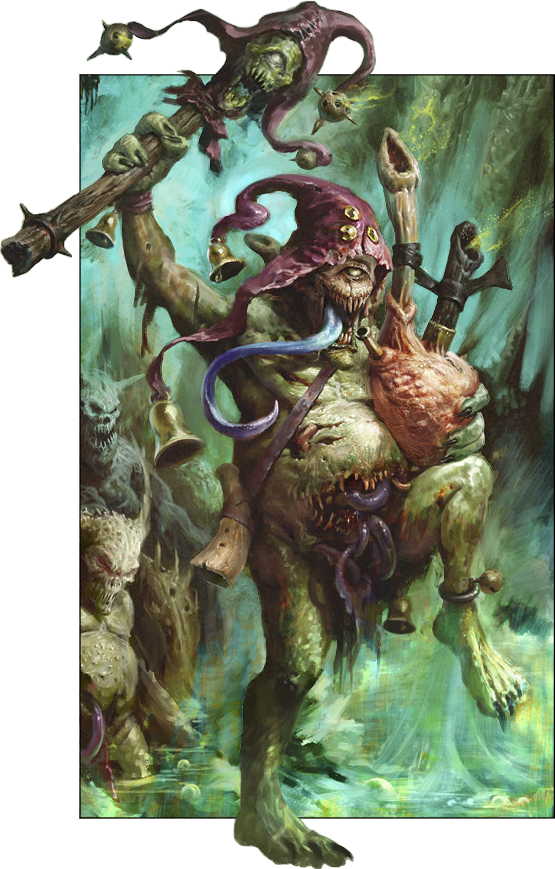 |
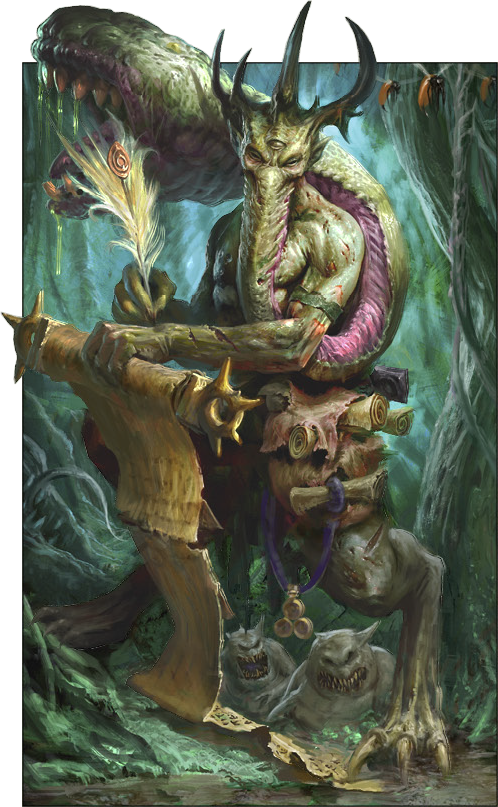 |
In the Garden of Nurgle it is a great honour to serve amongst the foot soldiery of the God of Decay, but there are some amongst the ranks of the Plaguebearers that are destined for still greater things. Those that prove exceptional in terms of power, ability or capacity to bear the most loathsome of diseases are granted further blessings from Grandfather Nurgle.
In the vast shadows of the Great Unclean Ones are Nurgle's Heralds, the commanders of the Plague Legions' Tallybands. These champions of plague and misery use their grotesque abilities to lead and augment the Lesser Daemons beneath them, or to perform the most vital duties throughout their god's garden. The Heralds of Nurgle each have their own proclivities and armaments, and are given impressive titles based on these.
A mortal who resists the ravages of Nurgle's Rot for a significant time transforms into an unusually resilient Plaguebearer, resulting in a larger, tougher individual destined to one day reach the rank of Herald as a Poxbringer. Such warriors are testament to the futility of denying Nurgle's embrace, but speak volumes about how much the Lord of Decay values determination and the most obstinate perseverance. Through their will and defiance, the Heralds-to-be stand taller and broader than the Plaguebearers that surround them. Upon proving themselves in battle or service, each is rewarded by Nurgle himself. The first sign is a lengthening of the single horn that juts out of their misshapen heads, followed by the sprouting of a magnificent set of rotting antlers as if to crown such malformed glory. Further engorged by the touch of blessed diseases, Poxbringers grow stronger and tougher still, becoming true champions of their kind. With their newfound strength, a Poxbringer can hack down multiple Bloodletters with a single swing of their balesword.
The change undergone by Poxbringers is more than just a physical one. Imbued with a generous portion of the unnatural vitality of Nurgle, Poxbringers project an aura of disease. This vile atmosphere is sometimes visible as a hazy fug that surrounds them. So noxious are these emanations that they can empower fellow minions of Nurgle. This ability makes Poxbringers the ideal lieutenants to lead a unit of Plaguebearers into battle, for the Herald's energies invest his charges' plagueswords with further virulent might, allowing for a greater spread of disease. With a single bale-eye glowing, Poxbringers can also tap into psychic powers, using them to vomit forth diseases or smite down the foe with horrific viruses.
Unlike the jolly Great Unclean Ones, Poxbringers are closer in temperament to Plaguebearers, but even less morose. As they are filled with a greater portion of the curdled energies of Nurgle, Poxbringers are gifted with far more personality than any of the droning Lesser Daemons they lead, most typically expressed in their gallows sense of humour. The Poxbringers pit their mumbling gripes against the boisterous, booming voices of the Greater Daemons that lead them, one side hopeful and ebullient about what might be done, the other grousing as they are the ones tasked with actually doing it.
In addition to leading Plaguebearer formations, Poxbringers can also be found in a variety of other roles, both in the Plague Legions and throughout the Garden of Nurgle. Powerful Great Unclean Ones use Heralds as subordinates, personal disease-tasters or right-hand advisers. Lord Dhripit the Grand Ulseer - a rising favourite of Nurgle - often deploys seven Heralds as his own formidable honour guard. The Poxbringer Ghlub'tar fell out of favour due to his unceasing stream of glum retorts, and was put in charge of the Nurgling masses that followed the legion into battle during the final stages of the Plague Wars in Ultramar. While originally envisioned as a punishment for his sour attitude, the results of his Nurgling assault waves were so impressive that the position has since become a permanent one. Ghlub'tar, naturally, grumbles about this constantly.
Always watchful of his minions, Nurgle himself selects the most accomplished of his Poxbringers and amply rewards them with special tasks. This is a true honour and such duties are discharged with solemn pride, be it as guardian of a sacred site in the garden, or as an observer of some new disease. One such individual is Wretch Gab'larr, who is tasked with studying the effects of Nurgle's plagues upon specimens never before encountered, then describing them to his master upon the porch of Nurgle's manse.
'Grumbling? I'm not grumbling. I should be grumbling, though, leading this lot of stumbler-mites. 'Tis the chanting I can't abide. Always the Eyerot ditty, never willing to give another disease a chance. And there they go again, not even worthy of their mucus...'
— Ghlub'tar, a sample of his stream of invective
Not all of the plagues created by Nurgle turn out as planned, many of them being just a minor inconvenience rather than a world-sweeping contagion. Some attempts prove even more disastrous, such as the pox that was meant to gnaw flesh but instead proved to be something of a disinfectant. That catastrophe was never spoken of again, not even by the boldest of Great Unclean Ones. The disease that eventually became known as the Chortling Murrain was at first believed to be a damp squib, but, when it was re-purposed as a punishment, it swiftly became one of the Lord of Plagues' favoured creations.
The Chortling Murrain becomes truly infectious when it settles into a Plaguebearer. Ever the most organised and glum of Nurgle's creations, a Daemon infected with Chortling Murrain - usually as a result of failing in his counting - abandons his characteristic shuffling gait and steady, measured droning as he falls into what can only be described as a comedic fever. So infected, he capers and quips, jabbering light-heartedly at any who will listen. Amidst the dour, endless counting of Plaguebearers it is only too obvious to pick out one who is so afflicted.
Once the symptoms of the Chortling Murrain fully manifest, its victim is given the title of Sloppity Bilepiper and a new task. Gifted with a gutpipe and marotter, these budding Heralds are sent to amuse Nurgle's Tallybands as they march to war. Admittedly, the antics of the Bilepipers wholeheartedly fail to impress the gloom-ridden Plaguebearers, but Great Unclean Ones and Nurglings find the steady stream of jokes and nonsense-songs hilarious. The Greater Daemons unleash booming belly laughs that send rotted innards splashing out in waves, while Nurglings shriek with laughter. Even Beasts of Nurgle flop about with extra enthusiasm, not understanding but eager to join the fun. Invigorated by the Bilepiper's exploits, Great Unclean Ones and Nurglings set about their vile work with extra vigour.
Unfortunately for Nurgle's foes, Daemons with the Chortling Murrain are infectious, and the warp-borne disease can cause mortals and the Daemons of other gods to laugh with ever-growing hysterics until their hearts burst or their sides split open. Despite their augmentative roles, Bilepipers themselves are doomed, for the Chortling Murrain always gets the last laugh - or not. As the disease goes into remission and the bearer fails to raise the least of titters from even the jolliest of Great Unclean Ones, the Herald is subjected to cruel magic that devolves him in twisting agony, reshaping him into a set of pestilential gutpipes - the tools of the trade that will eventually be given to his desperately grinning replacement.
The Heralds known as Spoilpox Scriveners are given a specific task by Grandfather Nurgle. It is their lot to tally the Tallyband, to audit their ceaseless counting, and to ensure that their calculations are accurate. To accomplish their role, Scriveners are equipped with endless hidebound scrolls upon which they use special quills made from the plucked tail feathers of a Lord of Change. They record the number of diseases counted by the Plaguebearers - to double-check later - and scribble down the names of any Plaguebearers that lose count. All the while, Scriveners verbally browbeat those around them, their nasal voices amplified by their distended jaws, which can bite a man in half. Such constant abuse has a strange motivational effect upon the Plaguebearers, forcing them to concentrate upon their chanting count and move with all the haste their swollen, fluid-ridden joints can muster. Spoilpox Scriveners themselves are sullen and spiteful creatures; they long to catch their fellows out with a mistake or, even better, to record enough wrongdoing to actually punish them. Those found to make repeated mistakes are slated for the dread fate of the Chortling Murrain.
The task of cataloguing the potency of Nurgle's many diseases falls to Epidemius, the Lord of Decay's chosen Tallyman. Epidemius is one of the seven Proctors of Pestilence who preside over the massed legions of Plaguebearers that answer Nurgle's call. Borne aloft on a rotten palanquin by a horde of Nurglings, Epidemius moves amongst the Daemons of Nurgle, making note of all the varied afflictions and poxes unleashed into the universe. It is a never-ending task, for Nurgle is constantly creative and his anarchic hordes are ever keen to spread new and wonderful diseases.
Epidemius' Nurglings are not only his means of transportation, but also act as his assistants, secreting ink for his quill, growing parchment-like strips of skin from their backs for their master to tear free, and counting upon a great death's head abacus that grows from the planks of the palanquin. The Nurglings also serve as guards for the Tallyman, biting at the ankles and shins of any who threaten their beloved master. Unlike the usual babble and giggling that accompanies most Nurglings, Epidemius' brood are almost silent. They understand the importance of Epidemius' task and suffer his ire when an ill-timed titter or rasping belch breaks his concentration. Nurgle's Tallyman brooks no idleness or foolishness; hence his passage is accompanied only by the slimy squelching of the palanquin and the gnawing scratch of his quill.
Nurgle's diseases afflict souls as well as bodies, destroying a being's sense of self and moral direction as thoroughly as they ravage the flesh. Epidemius can track the crumbling soul trail of the recently slain, gleaning all manner of knowledge from it, as well as siphoning a portion of the spirit's strength to aid his master's cause. As an offer of thanks, Epidemius' entourage strike bells, the doleful sound celebrating as the spirit leaves for Nurgle's welcoming embrace.
Epidemius can be found wherever Nurgle's pestilent gifts are most bountiful. His corpulent frame - resembling that of an extremely bloated Plaguebearer - is often seen upon the battlefields of realspace, for infected injuries and fresh corpses are fecund breeding grounds for contagion, and the stench attracts Epidemius like a fly to a rotten wound. Amidst the raging conflict, Epidemius surveys the spread of filth and decay from his lofty perch, taking careful note of every bubo, pustule and sore. Even as Epidemius writes, Grandfather Nurgle becomes aware of his findings, distilling the information for future experiments and brews. The more notes Epidemius makes, the more the Lord of Decay's attention is drawn to him, and the greater the blessings bestowed upon his pestilent legions. To better observe the spread of disease, Epidemius orders his palanquin carried to the front lines, where the Nurgling bearers and the obese Herald angrily strike out at any foes that get close enough to disturb the Tallyman's work.
At the zenith of one of the Blood God's reigns of dominance in the Great Game, Tzeentch encouraged Nurgle to invade the realm of his brother Khorne, assuring him that both his own legions and those of Slaanesh would aid him. Convinced, the Great Corrupter sent his most faithful servants to the Skull Lands, instructing them to take the bounty of his garden with them. Sure enough, powerful Tzeentchian illusions drew many Blood Legions away to chase phantom armies, rendering Khorne's armies vulnerable to the combined forces of his rivals. So great were the Blood God's losses in the ensuing conflict that the minions of Khorne were pushed back to the very walls of the Brass Citadel.
All around that indomitable fortress, vast swathes of the Garden of Nurgle had sprouted, the land ploughed and seeded by Horticulous Slimux and watered by Rotigus the Rainfather. With victory seeming certain, a supposedly stray spark of warpflame from a Herald of Tzeentch ignited Nurgle's flora, dried out as it was by the desert heat of Khorne's underground forges. The resultant inferno created a wall of flame around the citadel that utterly engulfed Nurgle and Slaanesh's legions, and began to spread uncontrollably back to the centre of the Plague God's domain. Only by Rotigus' quick thinking was the blaze prevented from reaching all the way back to his master's manse, as he called forth a bigger deluge than he had ever previously manifested. Seeing the towering flames around the citadel, Khorne's Blood Legions realised they had been tricked, and returned to repel the last of the invaders.
With a thump of his tumour-hardened foot upon the shell of his faithful mount, a snail-like creature known affectionately as Mulch, Horticulous Slimux rides to battle. It is not the quickest of charges, but what it lacks in speed it makes up for with sheer toxicity.
Horticulous Slimux has been Nurgle's head gardener since before time. A Herald of special powers, Horticulous has an eye for tending the diseased plant-growths so beloved by Nurgle. None knows better when to deadhead a skullrose, divide up a witchspike shrub, or graft new tendrils together to make entire new flora. Indeed, if he had his way, Horticulous would spend all his time tending and pruning the endless vegetation fields around Nurgle's great manse. The Lord of Plagues, however, has other ideas.
Nurgle moves in cycles, and after seeing his Grand Cultivator at work in his garden for a time, the God of Decay senses the need for a change, and sends Horticulous into realspace to plant his seeds. There is none better at spreading the glorious growths of the garden. Horticulous is a pragmatic and humourless being, and goes about his task - whatever it may be - with the same no-nonsense approach. He finds the uncontaminated regions of reality disturbing, and seeks to garnish them as quickly as possible with Nurgle's blessing, although he will grumble as he does so of his 'beauties back home', for he trusts no one to tend his prized plants in his absence. But no sooner has Horticulous set his grundleplough working than Nurgle grows restless again. He decides that now is not the time for planting, but instead the time for reaping. And so, hefting his rusty pair of pruning shears, Horticulous joins the Plague Legions for battle. Heads and limbs are snipped with the same precision and skill he shows when trimming down a bleeding marrowtree.
As he goes about his duties, Horticulous conjures the tendrils and mutated fronds of Nurgle's garden and ushers them into reality as if with only a thought. Within moments of sowing a seed, a boundless fecundity erupts, creating a small facsimile of his master's garden. Such infested areas, populated by the likes of daemonic Feculent Gnarlmaws, augment the diseased hordes of Nurgle and cause all others to weaken in the unnatural miasma.
It is rare to see Horticulous alone, for he is almost always accompanied by bounding packs of Beasts of Nurgle. The creatures frolic in the slimy and poisonous wake left behind by the Grand Culvitator's squelching mount, and will respond to the Herald's call with unmatched enthusiasm. Horticulous tolerates the Beasts' antics, but the same cannot be said for Nurglings. When no Great Unclean Ones are watching, Horticulous has been known to feed the imps to Mulch. This foul diet ensures Mulch's bite is extremely toxic.
The dull knell of bells and the humming of flies herald the arrival of Nurgle's Plaguebearers, the rank-and-file of the Plague Legions. Each Plaguebearer is formed from the corrupted soul of a mortal that contracted Nurgle's Rot. The longer a victim endures against the soul-gnawing disease - which varies in virulence - the greater the boon of power granted by the Lord of Decay. The Daemon shuffles forwards, its ripe body swollen and bursting open with contagion. The stench of unnatural decay hangs heavy, surrounding the Plaguebearer like a fug. Each Daemon has a single rheumy eye and a horn sprouting from its skull - the mark of Nurgle's Rot that each bears through eternity. What little flesh it has remaining is stretched over ruptured organs and marked with innumerable sores and dripping cysts.
It is the Plaguebearers' role to keep stock of new diseases, and to maintain some semblance of order amongst Nurgle's naturally mischievous hordes. The Plaguebearers' obsessive need to organise is characterised by their constant counting as they try to calculate every new outbreak of plague, an onerous duty that they carry out begrudgingly. In truth, their monotonous chanting achieves very little save for making mortals feel nauseous - it is practically impossible to catalogue anything amidst the ever-changing nature of Chaos. This in no way discourages them, however, for they are the embodiment of the need to impose order upon a meaningless and uncaring world. Unfortunately for the Plaguebearers, they are prone to losing count during the back-and-forth mayhem of combat, and the glum Daemons groan in frustration before starting their count all over again. Such sights rarely escape the eye of any nearby Spoilpox Scriveners, who are eager to punish any they can for their failings.
In battle, Plaguebearers shamble purposefully towards their foes. Packs of these Lesser Daemons - often up to seven of them - are known as the Tallybands, and form the core of many of Nurgle's Plague Legions. Each Plaguebearer wields a rusted blade that corrupts flesh in an instant. Should a foe endure the stench and not be struck down, they will find their own blows hampered by swarming flies.When strikes do land upon Plaguebearers they seem to have little effect, for the minions of Nurgle feel no pain, and shrug off what should be lethal strokes.
Each Plaguebearer carries a gnarled and spike-ridden blade - an infamous plaguesword. Although corroded and battered, these blades drip with a coating of loathsome slime whose touch brings disease and death. As Grandfather Nurgle enjoys each of the wide variety of splendid aliments at his command, there is no telling exactly what might be contracted from a scratch suffered from a plaguesword. Victims not slain outright have been known to come down with all manner of gruesome and deadly maladies.
The innards of a Great Unclean One are best not pondered, for such gastric caverns are not places that sane men wish to consider for too long. It is in these churning depths that the Nurglings are created. Starting as small blobs of indescribably foul matter, Nurglings are nourished by the pulsating juices of a Great Unclean One's inner organs, growing into small facsimiles of Nurgle himself until they plop into existence as spiteful, rotund imps.
For most of their existence, Nurglings congregate around the Great Unclean One that created them. They clamber across his bulk seeking comfortable pools of liquids and warm spots under the folds of rotting flesh. Eager for attention, Nurglings chatter to their master incessantly, picking at his scabs and hoping for a fatherly belch of appreciation. Some of Nurgle's favoured Heralds are accompanied to battle by seething tides of these diminutive monsters; those most vaunted in his sight are carried in a palanquin which is borne aloft on a carpet of Nurglings. When not moving the palanquin, the grotesque imps will scurry around making gifts of small trinkets they find; dead animals, rotting bones, particularly splendid fungi and other such presents as they think will please their master.
Nurglings are mischievous little creatures, and when they aren't squabbling with each other or vying for attention, they are typically making a nuisance of themselves by spreading boils, spoiling foodstuffs, or else leaving slippery piles of filth for unsuspecting mortals to step in. Of all Daemons, it is Nurglings that most vex the Plaguebearers; driven by the instinct to record and codify, the Lesser Daemons of Nurgle find the capricious, trouble-causing nature of Nurglings impossible to fathom. Whilst Great Unclean Ones look upon their pestilent children with affection, the sombre Plaguebearers view them as a constant distraction.
Nurglings are rarely a formal part of any of the Plague Legions, but instead they tag along, cavorting upon the heels of the commanding Great Unclean One or scampering amongst the Heralds and troop formations. They are very protective creatures and will gleefully launch themselves at foes that threaten them or their friends. They swarm forwards in a rush of malevolence, spilling over their victims like an irrepressible tide. Possessed of pointed teeth and sharp claws, the Nurglings swallow up their enemies in a mound of biting, scratching bodies. Such small wounds as are inflicted by these minuscule creatures would be inconsequential were it not for the lively toxins and contagions from which the Nurglings are made, which quickly infect and mortify even the slightest injury.
Since the coming of the Great Rift and the outpouring of warp energies into the galaxy, Nurglings have become far more prevalent in realspace. Several new diseases, including the latest strains of the Zombie Plague, are so virulent that they allow Nurglings to develop inside those afflicted. When the malevolent creatures slop forth - eating their way out or perhaps bursting from a cyst - they do their best to spread even more diseases.

The creatures known as Beasts of Nurgle are so ugly that a mere glimpse of their diseased forms is enough to make a mortal vomit. However, it is an appearance that is totally at odds with their friendly and energetic demeanour. This is because Beasts of Nurgle are incarnations of the Plague Lord's own bountiful exuberance, which is in turn a manifestation of all mortals' desire for vigorous life, social interaction, affection and fertile endeavour.
In character, Beasts of Nurgle are much like energetic, attention-starved puppies. They often accompany Nurgle's Legions into battle, flyblown tongues lolling out of putrid mouths as they bounce back and forth to attract the attention of Grandfather Nurgle's favourite sons, hoping for a pat on the back, a rub of the belly or some other scrap of attention. When happy, Beasts of Nurgle wag their slug-like tails back and forth. When over-excited (which is most of the time) they leave little puddles of caustic slime behind them. Beasts of Nurgle are affectionate creatures that love nothing more than to bound up to potential new playmates and slobber all over them. Those who foolishly run away from the Beasts of Nurgle in an attempt to escape only serve in rousing the creatures' instinctive enthusiasm, for they simply cannot resist a good game of chase, bounding after their panicked friends with phlegm-choked barks of excitement.
Unbeknownst to the cheerful but dim-witted Daemons, their bodies are dripping with a whole host of virulent plagues and contagions. Even the proximity of a Beast of Nurgle is enough to spell death for small animals and plants. The mere touch of a such a creature is quickly fatal to most mortals, causing aggressive diseases to run rampant through their bodies at an accelerated pace. Soon the victim falls silent and still, already decaying under the malign influence of Nurgle's infections.
The Beasts of Nurgle only register a fleeting sense of disappointment at their new friend's lack of spirit, and will quickly grow bored of their game, eagerly searching for new playmates upon which to lavish their lethal devotion. More gruesome still are those times when the simple-minded Beasts of Nurgle mistake their victim's convulsive throes for a new game - eager to join in the fun, they quickly drop to the ground to roll around as well, crushing their poor friends' ravaged bodies to a pulp in the process. When the Beasts of Nurgle finally right themselves, they find that their playmates have mysteriously disappeared from sight. Assuming that they've been abandoned, they set about a pathetic, heartfelt whimpering - that is until they are distracted by the pool of gruesome fluids that has inexplicably appeared about them, which they set to lapping up with relish.
'By the time ye bones begin to rot,
Gribbleworms are still there,
But you are not...'— Nonsense rhyme of Gryst, the ill-fated Sloppity Bilepiper
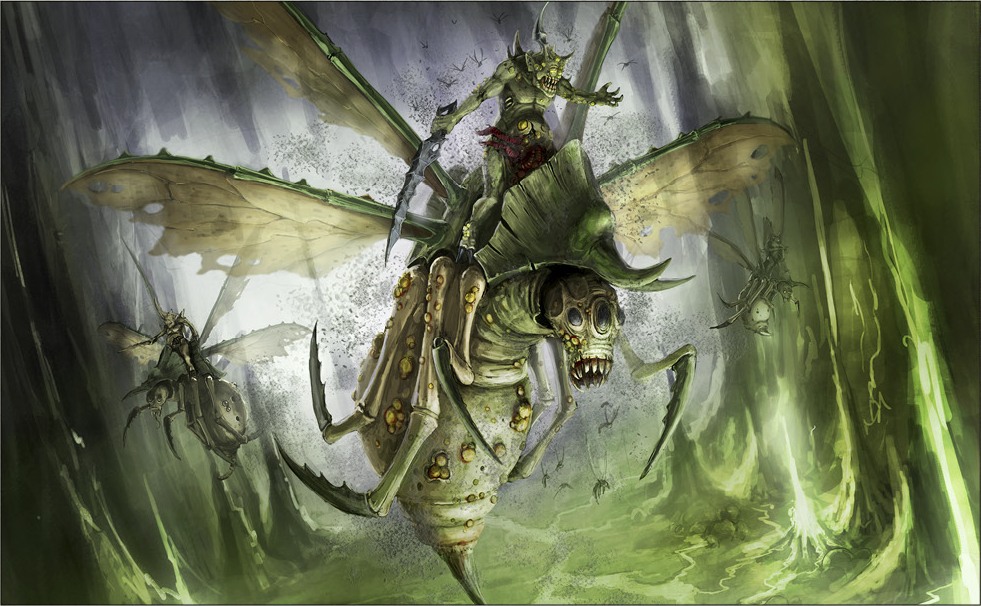
High-ranking Plaguebearers are known amongst Nurgle's legions as Plague Drones, a title that conveys commendable humility. These overseers of Nurgle's realm ride into realspace mounted upon Rot Flies - colossal daemonic insects whose appearance is so repugnant it scars the mind. From their lofty positions, the Plague Drones can properly tally the diseases running rife across the battlefield, as well as swiftly intervene should Nurgle's divine plans meet with heavily armed resistance.
The Rot Flies themselves are amongst Nurgle's most loathsome creations. Only the forbidden tomes of the Black Library speak of the vile process by which these creatures are birthed, for they hatch in the sticky depths of the Garden of Nurgle, where the visionary and the loon wander in their dreams and nightmares. Some Beasts of Nurgle, disappointed by the ragdoll inactivity of their mortal playthings, develop a kernel of bitterness in their ebullient souls. Crestfallen puzzlement leads to frustration and ultimately an aching resentment. Over the millennia, a thin seed of malice grows in such a Beast's heart, feeding upon the energies of its depression and angst until it throbs like a pus-filled canker.
The final straw comes when the Beast is betrayed unto death by those it wishes to call its friends. Seeking reconciliation, the Beast will put aside its doubts and bound optimistically towards the ranks of those mortals it has cornered. Should one of these ingrate warriors slay the Beast with a lucky sword thrust or well-aimed plasma blast, the creature will vanish howling into the warp. Called back to the immaterium, the Beast lollops and huffs, splashing down into the mire of Nurgle's garden with an aggrieved sigh. The knowledge that it cannot return to the delights of the mortal realm festers within it as it wallows in the sheer unfairness of the universe.
Over the centuries the Beast pupates, protected from harsh reality by a crawling shroud of Nurgle's fattest flies. A daemonic metamorphosis takes place as the chitinous nub of hate that lurks within the Beast grows strong on the sallow bulk of its former incarnation. Eventually, the creature within bursts out of its cocoon as a full-grown Rot Fly, a creature of pitiless malice hell-bent on wreaking its revenge upon an uncaring universe. Plaguebearers prize such steeds highly, for in their haste to punish the mortals that once spurned them, Rot Flies speed into battle at a great pace.
As the Rot Flies fall upon their prey, leathery wings buzz in a flapping purr of motion and clouds of deathbottles fill the air above, choking airborne warriors and clogging engine intakes. Prehensile probosces and posterior mouth-parts latch onto the faces of their victims, and the Rot Flies let out titters of mean-spirited laughter as they pluck heads from necks and swallow them down. When facing the common soldiery of realspace, a Rot Fly will slowly digest all meat from a skull before extruding a plague-infused death's head that its Plaguebearer rider can hurl at the foe. Given the chance, though, Rot Flies will hunt down the heroic warriors that slew their previous incarnations. A special fate is reserved for such individuals - opening their maws wider than physical law should allow, the Rot Flies swallow their prey whole, keeping them trapped in their mucus-filled abdomens for eternity.
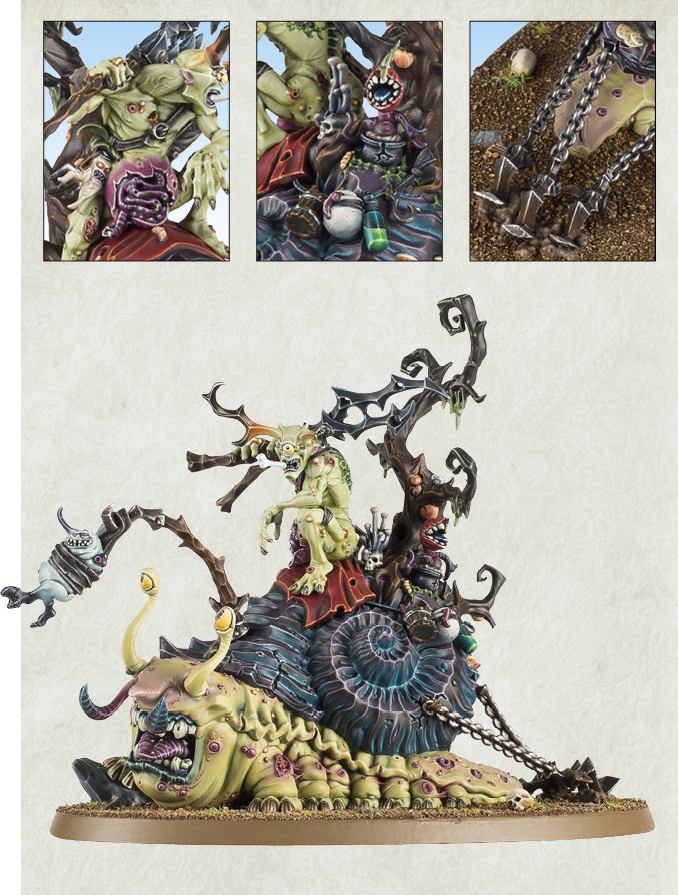
Horticulous Slimux, the Grand Cultivator
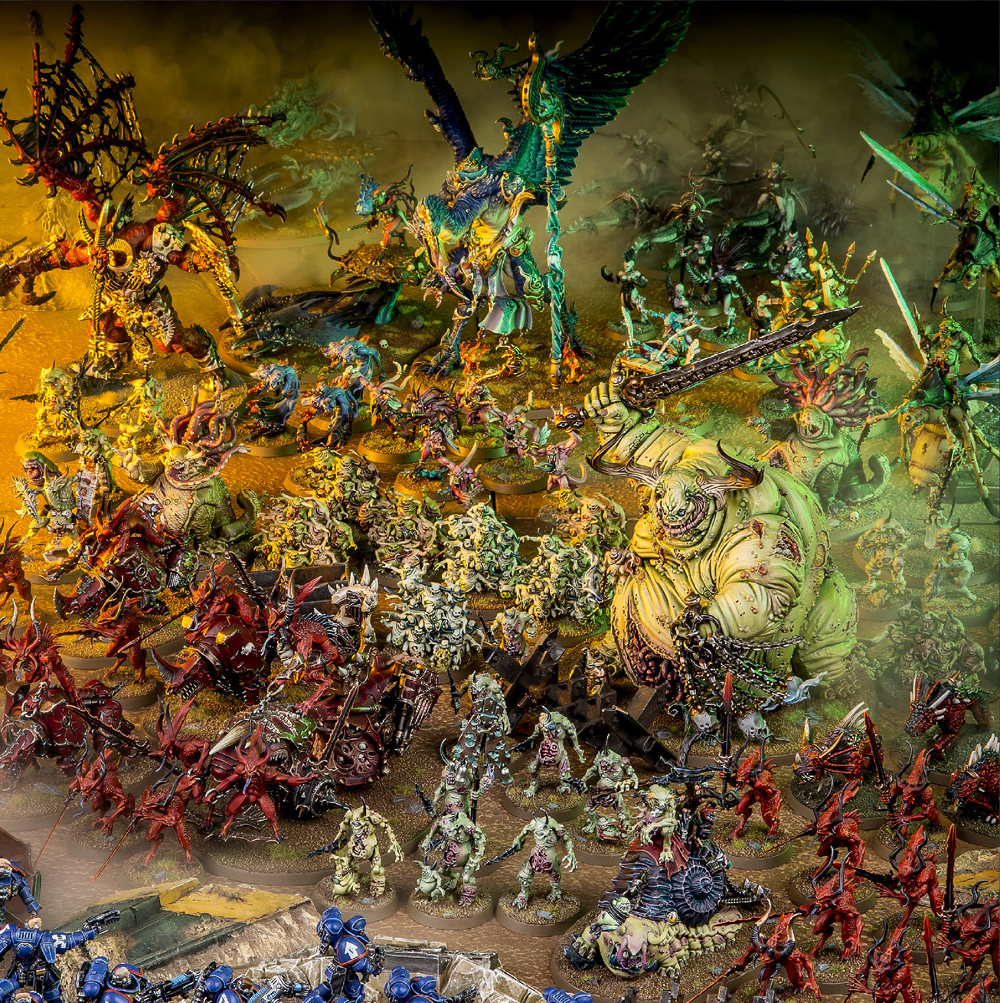
From the warp they come, bearing gifts of destruction and corruption. An army composed of Daemons from each of the Chaos Gods bears down upon the Ultramarines' defence line, seeking to smash it asunder. No one will be spared on this planet, or any other, and the wars will continue until the forces of Chaos hold sway over the entire galaxy.
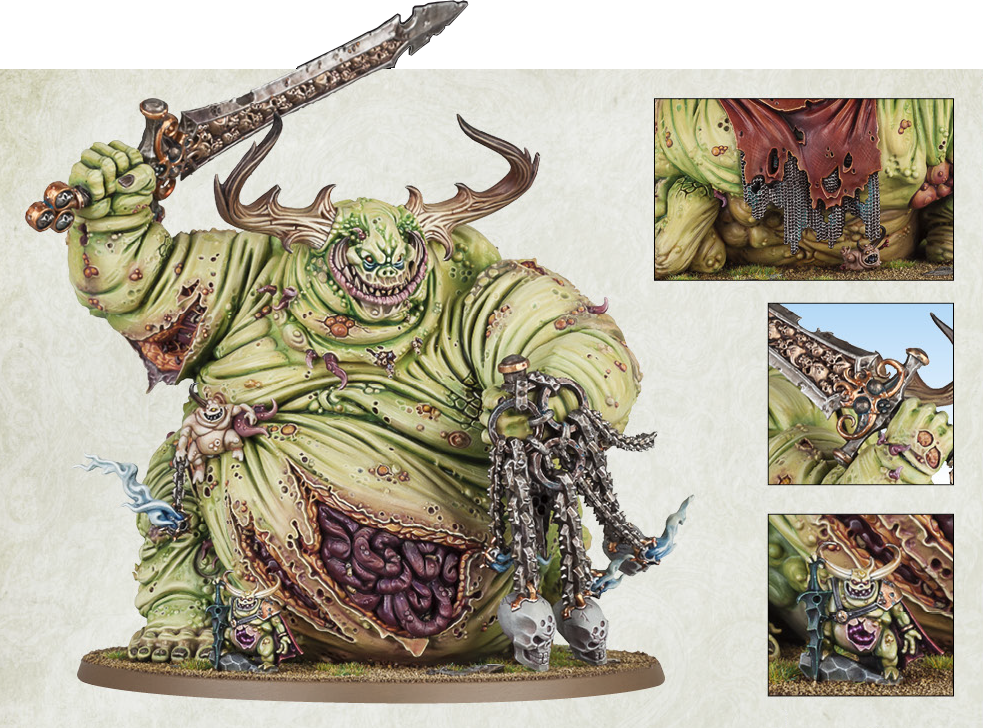 Great Unclean One with bilesword and plague flail |
||
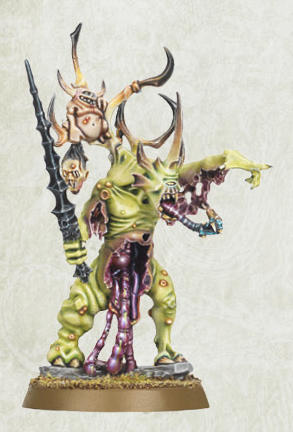 Poxbringer |
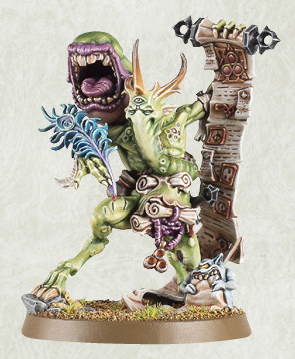 Spoilpox Scrivener |
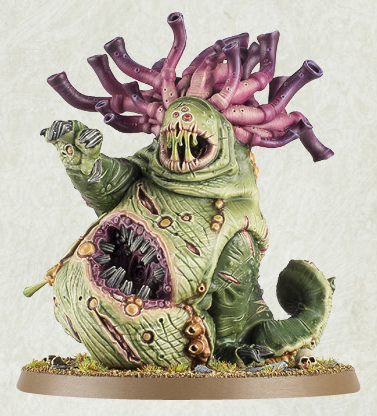 Beast of Nurgle |
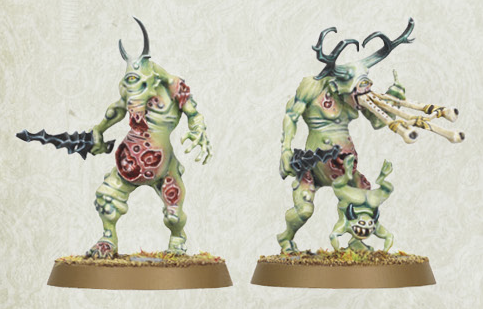 Plaguebearers of Nurgle |
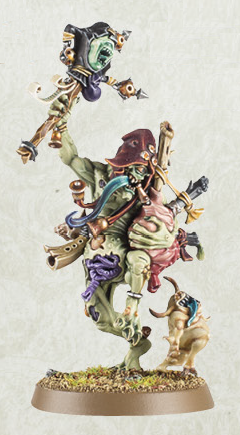 Sloppity Bilepiper |
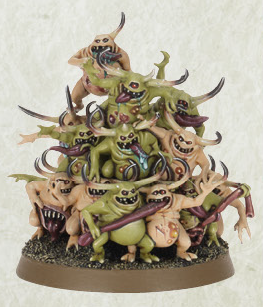 Nurgling Swarm |
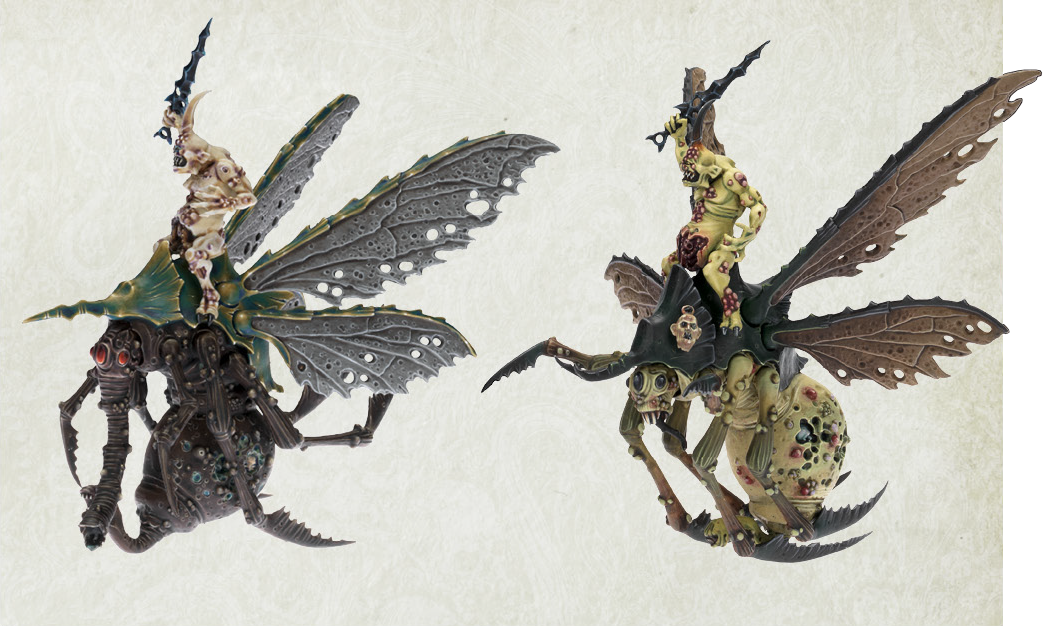
The cavalry known as Plague Drones are formed of Plaguebearers mounted upon Rot Flies. The colouration of both rider and mount often reflects a particular stage of Nurgle's cycle of decay and regeneration.
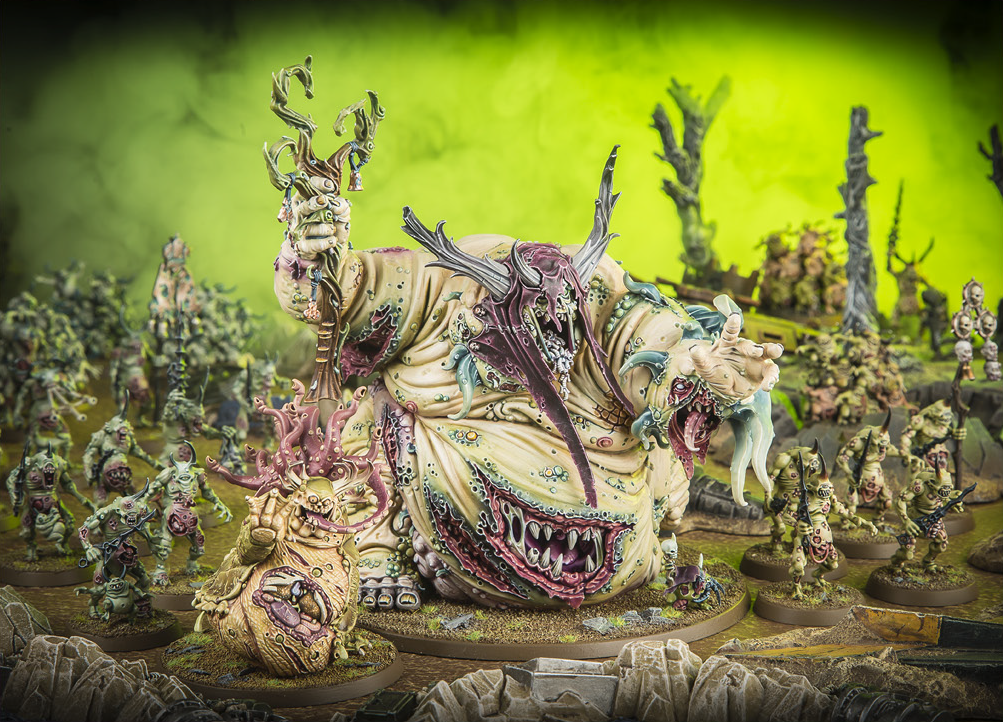
Rotigus the Generous One leads the shambling and ooze dripping hordes of Nurgle to pollute another world beyond all hopes of redemption. Truly does the monstrous Great Unclean One bring a foetid tide of filth wherever he strides.
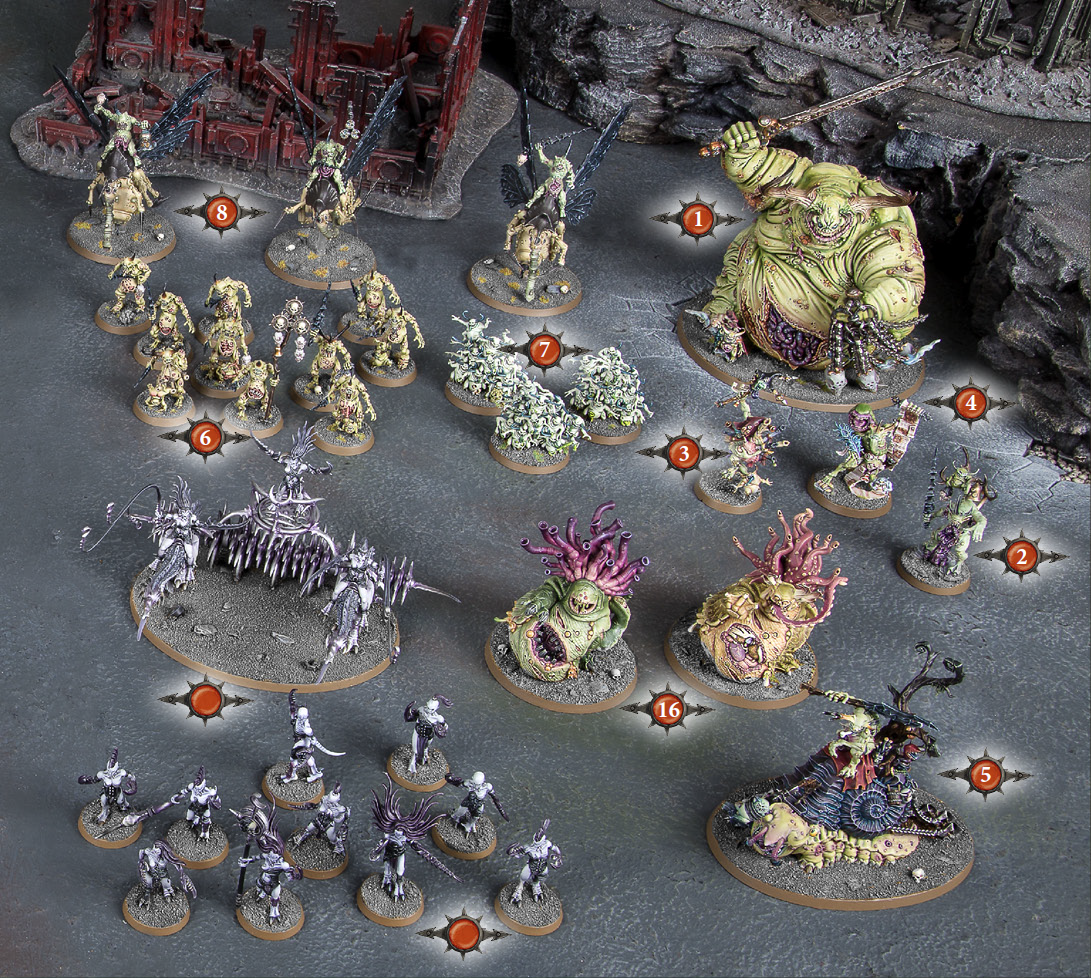
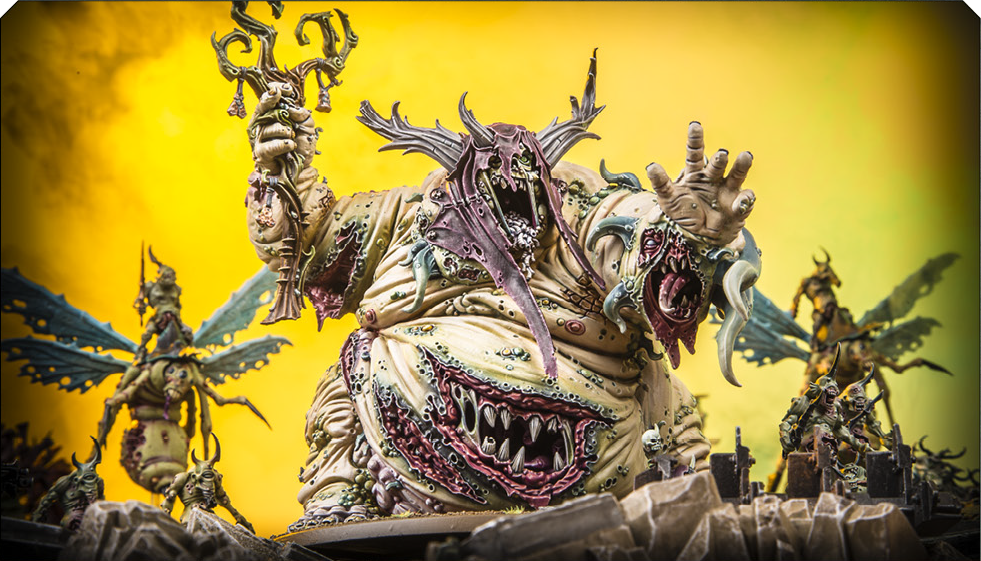
Rotigus arrives upon the worlds of realspace in a deluge of blight and infectious disease. Those who will not submit must wither...
'Wither when you stand, toll the bells of the Tallyman.
Sores that run with pus, toll the bells of Epidemius.
Boils that grow and pop, toll the bells of Gru'glop.
Come rains of gristle-pus, toll the bells of Rotigus.
Seeds that are bibulous, toll the bells of Horticulous.
The tallow is lit to light you to bed, the plaguesword is coming to chop off your head.
Chip chop, chip chop, 'til the last of them are dead.'— Drone-chant led by Gru'glop, Poxbringer of the Dirgebells
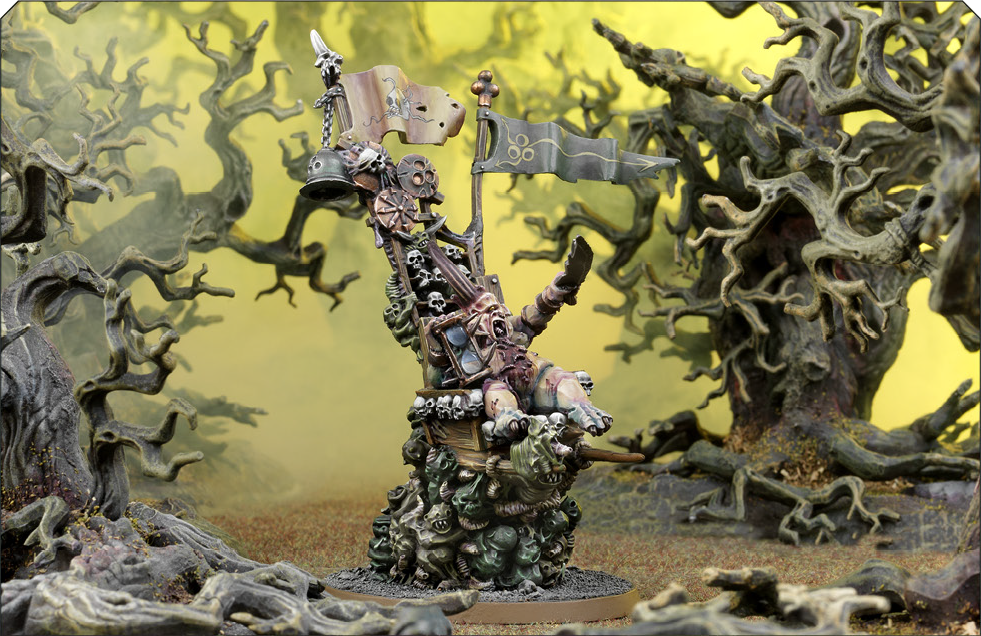
Carried upon a palanquin by Nurglings, Epidemius is Nurgle's Tallyman, and it is his task to count the souls of the diseased.
'The seed has been well planted. I can feel spines curving in crookbacked pain, straight shoulders lurching 'neath the weight of newly grown mounds. I hear the sound of diseased bellies bloating near to bursting, straining as they fill with glorious fumes. The sprouting of bulbous growths is like a divine chorus. Rotflies buzz, their mating song ensuring worm-spores will soon burrow out of flesh in their writhing multitudes. And the smells... oh, the smells! They are best of all. I detect an air of pungent necrosis, sweet like the glorious wafts from overripe fruit, yet underneath there resides a sour tang of spoiled milk. The scent is so rich I can almost taste it. Yes, my children, my splendid children - we have done good work here. This world will be a fine addition to Grandfather's garden. I congratulate you all on your earnest efforts.'
— Lord Guttrol, commander of the Bacillus Legion, upon viewing the aftermath of his Rot Legion's attack upon Iax in Ultramar
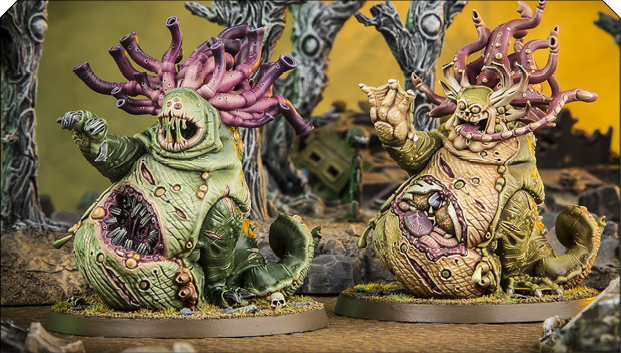
Although their bounding personality is more akin to that of a domesticated pet, a Beast of Nurgle's attention brings only death and agony.
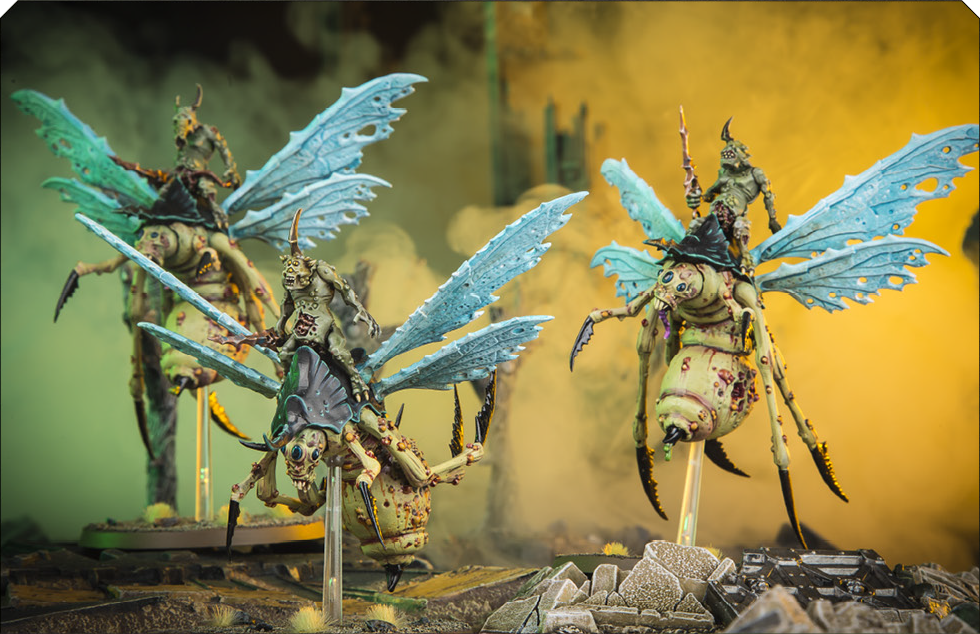
With a sickening buzz, the Plague Drones of Nurgle drop out of the skies to begin an assault.
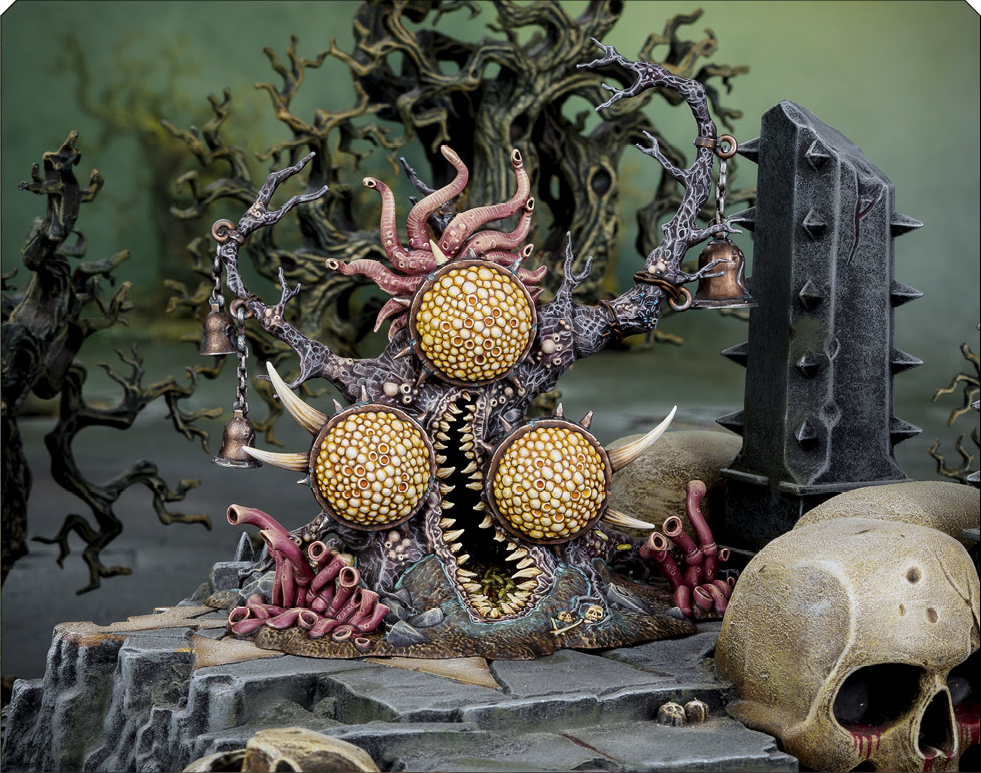
The unnatural tolling of the Gnarlmaw's bells invigorates Nurgle's Daemons, while calling more of their foul number into realspace.
With the War in the Rift deadlocked, the Chaos Gods arranged a formal contest to end the conflict - a great gladiatorial fight between their champions. Few mortal creatures know much of that battle, save for the disturbed dreams of prophets or insane sermons spouted by sorcerous cultists.
The battlefield itself was created when Khorne, Tzeentch, Nurgle and Slaanesh each ceded part of their realms to create a hellplane all its own. So was Amalgrimm born, a prize that would be claimed by the winner.
Tzeentch sought to define the criteria by which the contest would be judged. The others, most vehemently Khorne, refused to be bound by such arbitrations, believing the last Daemon standing should decide the victor. The Blood God's only concession to the long list of Tzeentch's stipulations was to agree to limit the number of combatants, believing martial honour to be paramount. It is unknown exactly how many took part in that battle; some claim every god chose one hundred champions, each supported by a legion, while others suggest the size of the forces were based around each power's sacred number.
It was Slaanesh that attacked first, his Lashscourge Host led to battle by Ssi'lsh the Dominator, and it was they that swept away the vanguard of both Tzeentch and Khorne. However, Blothar, the most hulking of all Great Unclean Ones, deployed alongside his legion, and their advance could not be halted. More of Slaanesh's Legions of Excess took to the field, each of the Dark Prince's Daemons scoring a hundred blows for every one the diseased followers of Nurgle dealt, yet still it was not enough.
Back and forth the contest swayed, growing in scale and intensity. Upon heaving waves of fire, Skarbrand and Ghorgrax led the Rage Legions to annihilate Gol'grul and his seven Great Unclean One bodyguards. The Feathered Lord Tzax'lan-tar was struck from the skies by the Exalted Keeper of Secrets Prr-fra, and scores of individual duels erupted amidst the clash of legions. Bolts of change-magic felled Skulltaker, but Karanak, the Hound of Vengeance, reaped revenge, leading a charge that tore apart a coven of Lords of Change.
On it went, a swirling maelstrom for which each of the Chaos Gods cursed his brothers while channelling titanic energies to aid their embattled minions. Strange beasts were unleashed and powers of such magnitude unleashed that the warp itself shuddered. As the hellish attrition took its toll, it seemed that Khorne's champions would stand triumphant, until final trickery by Kairos Fateweaver stole the victory for his master. With victory slipping away due to Tzeentch's deceits, Khorne intervened, his bellow of rage sundering the Amalgrimm.
Thus concluded the War in the Rift, with each god declaring victory and disputing the claims of their brothers. The Great Game resumed, and realspace once more thundered to the sound of battle.
The Daemons of Nurgle are surrounded by an aura of pestilence and disease that infects all nearby, and their talons and blades drip with thrice-ripened plagues. The merest touch of such a weapon in the presence of such a creature can cause a mortal to wither and die in seconds.
Each time you make a wound roll of 6+ for a NURGLE DAEMON unit within 6" of any friendly model with the Locus of Virulence, that attack inflicts 1 additional damage.
Nurgle Daemons Stratagem
As the tolling of bells echoes through the warp, the flesh of Nurgle's Daemons flows like wax to seal gaping wounds.
Use this Stratagem at the end of your Movement phase. Select one of your NURGLE DAEMON units. One model in the unit regains D3 lost wounds. If there are no wounded models in the unit, and that unit has suffered any casualties, a single slain model from the unit is returned to play with one wound remaining.
Nurgle Daemons Stratagem
A pervasive aura of pestilence surrounds this icon, causing rusted blades to weep with even fouler and more toxic diseases.
Use this Stratagem before the battle. Choose one of your NURGLE models with a Daemonic Icon. That icon is upgraded to a Plague Banner. In addition to its normal ability, the power of the banner can be used once per battle, just before the bearer's unit fights. When used, increase the Damage characteristic of all plagueswords carried by the bearer's unit to 2 until the end of the phase.
Nurgle Daemons Stratagem
Wherever Nurgle's champions walk, disease blooms and maggots hatch from rotten flesh, sustaining his minions.
Use this Stratagem at the start of any phase. Select a NURGLE DAEMON CHARACTER from your army - until the end of the phase you can re-roll Disgustingly Resilient rolls of 1 made for friendly NURGLE DAEMON units within 6" of that model.
| D6 | Result |
|---|---|
| 1 | Blessed with Corpulence Nurgle's blessing upon this Daemon is plain to see, for his frame is hideously bloated and riddled with corruption. Add 1 to your Warlord's Wounds characteristic. |
| 2 | Acidic Ichor Those that pierce this Daemon's straining flesh are sprayed with sizzling bile that melts through armour, flesh and bone. Roll a dice each time your Warlord loses a wound in the Fight phase. On a 4+ the unit that inflicted that wound is splashed by acidic ichor and suffers a mortal wound after all of its own attacks have been resolved. |
| 3 | Plaguefly Hive This Daemon's pockmarked hide conceals a colony of plagueflies that swarm forth to bite and bedevil the foe should they get too close. Your opponent must subtract 1 from all hit rolls that target your Warlord if the attacking unit is within 7". |
| 4 | Virulent Touch So saturated with noxious toxins and vile poisons is this Daemon that its merest touch ensures a gruesome and deadly demise. Add 1 to all wound rolls made by your Warlord in the Fight phase unless it is targeting a VEHICLE. |
| 5 | Impenetrable Hide Beneath this Daemon's hide are layers of rotting blubber, a dense mass that must be dug through to reach the vitals buried beneath. Your Warlord has a Save characteristic of 4+. |
| 6 | Pestilent Miasma Those who venture too close to this Daemon find their injuries blackening in seconds and their infected flesh swiftly turning to rot. Roll a dice for each enemy unit that is within 1" of your Warlord at the start of your turn. On a roll of 4+ that unit suffers a mortal wound. |
If one of the following named characters is your Warlord, they must be given the associated Warlord Trait shown below.
| Named Character | Warlord Trait |
|---|---|
| Rotigus | Pestilent Miasma |
| Horticulous Slimux | Acidic Ichor |
| Epidemius | Virulent Touch |
Those slain by a Daemon crowned with the fabled Horn of Nurgle's Rot are doomed to rise once more, their soul infected with an aggressive strain of Nurgle's Rot that decays and transforms them in a the space of a few heartbeats. The victim's altered corpse soon stands once more to join the shambling ranks of Nurgle's Plaguebearers.
NURGLE model only. Roll a D6 each time the bearer kills an enemy model in the Fight phase whilst within 7" of one or more friendly units of Plaguebearers. On a 4+ you can add a single Plaguebearer model to one of those units.
To hear the grim tolling of this great bell upon the winds is a death sentence, for its sound heralds the arrival of the Plague Legions. Such is its dread power that a single peal reverberates for long minutes, spreading dread and despair even over the clangour of battle.
NURGLE model only. Enemy units must subtract 1 from their Leadership characteristic whilst they are within 7" of the bearer of the Entropic Knell.
This fabled weapon is the literal manifestation of corruption. Constantly dripping with foul ooze, the merest scratch from its plague-ridden edge is enough to lay low the hardiest foe, and its toxins can effortlessly overcome even the resilience of a Space Marine.
NURGLE model with plaguesword, balesword, bileblade or hellforged sword only. Corruption replaces the model's plaguesword, balesword, bileblade or hellforged sword and has the following profile:
| Weapon | Range | Type | S | AP | D |
|---|---|---|---|---|---|
| Corruption | Melee | Melee | +2 | -3 | D3 |
| Abilities: Re-roll all failed wound rolls made for this weapon. | |||||
| D6 | Result |
|---|---|
| 1 | Stream of Corruption The psyker spews forth a stream of disease on its enemies. Stream of Corruption has a warp charge value of 5. If manifested, the closest enemy unit within 7" of the psyker and visible to it suffers D3 mortal wounds if it has fewer than 10 models, or D6 mortal wounds if it has 10 or more models. |
| 2 | Fleshy Abundance Nurgle's bountiful energies surge through the target, healing their wounds beneath new growths of swollen flesh. Fleshy Abundance has a warp charge value of 5. If manifested, select a friendly NURGLE DAEMON unit within 18" of the psyker. One model in that unit regains D3 lost wounds. |
| 3 | Nurgle's Rot Gurgling praise to its god, the psyker exudes a wave of soul-pox that rapidly kills those who lack Nurgle's blessings. Nurgle's Rot has a warp charge value of 7. If manifested, roll a D6 for every unit (excluding NURGLE units) within 7" of the psyker. On a 4+ the unit being rolled for suffers D3 mortal wounds. |
| 4 | Shrivelling Pox Muttering an unholy chant in a blighted tongue, the psyker calls down poxed blessings on a chosen foe. Shrivelling Pox has a warp charge value of 6. If manifested, select an enemy unit that is within 18" of the psyker and visible to it. Until the start of your next Psychic phase, subtract one from the target unit's Toughness characteristic. |
| 5 | Virulent Blessing The psyker blesses its allies with a bounty of fresh diseases with which to infect their enemies. Virulent Blessing has a warp charge value of 7. If manifested, select a friendly NURGLE DAEMON unit within 18" of the psyker. Add 1 to wound rolls made for that unit in the Fight phase. Furthermore, wound rolls of 7+ made for that unit in the Fight phase inflict double damage. |
| 6 | Miasma of Pestilence As the psyker chants in a phlegm-choked drone, a dark cloud of filth and flies shrouds its allies from view. Miasma of Pestilence has a warp charge value of 6. If manifested, select a friendly NURGLE DAEMON unit within 18" of the psyker. Until the start of your next Psychic phase, your opponent must subtract 1 from all hit rolls that target that unit. |
For decomposition and eventual rebirth - even in a corrupted form - to take place, death must first occur. So do Nurgle's vassals dutifully perform their part in the endless cycle of life.
Score 1 victory point if an enemy INFANTRY unit was destroyed during this turn. If an enemy INFANTRY unit was destroyed by one of your NURGLE DAEMON units during this turn, score D3 victory points instead.